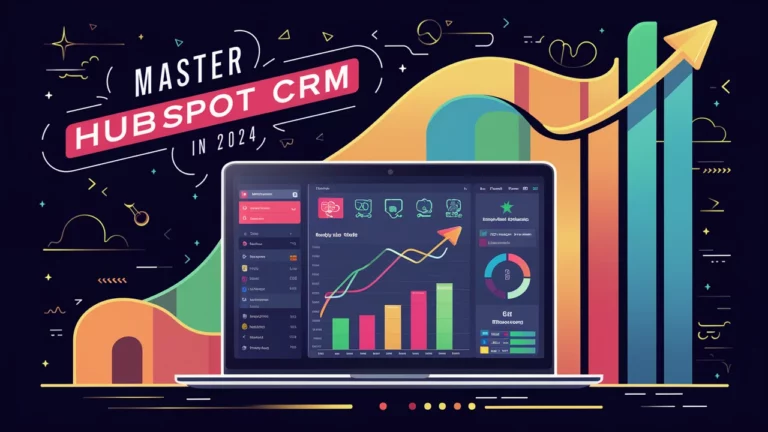AI for Business Automation: The Ultimate Guide for 2024

In 2024, AI for business automation is set to revolutionize the way companies operate. According to recent studies, the global market for Business Process Automation (BPA) is expected to grow by 30%, reflecting a strong shift towards integrating AI technologies to enhance efficiency and productivity.
Why is this growth so significant? Here are a few key benefits:
- Increased Efficiency: Automating routine tasks allows employees more time to focus on strategic activities.
- Cost Reduction: Minimizing labor expenses and errors translates to substantial savings.
- Enhanced Customer Experience: AI delivers personalized and timely services, boosting customer satisfaction.
However, implementing AI in business automation isn’t without challenges. High costs and technical issues can be barriers. Employee resistance to change can also pose significant hurdles. Despite these challenges, a well-thought-out strategy can help businesses navigate these obstacles and fully reap the benefits of AI-driven automation.
Understanding these dynamics sets the stage for delving deeper into how AI can transform business processes.
- Understanding AI and Business Process Automation (BPA)
- The Evolution of Business Automation
- Benefits and Applications of AI in Business Automation
- Real-World Use Cases: Successful Implementations of AI in Various Industries
- Integrating Robotic Process Automation (RPA) with AI Tools for Enhanced Capabilities
- Overcoming Challenges in Implementing AI for Business Automation: Strategies for Success
- Developing a Clear Implementation Strategy for Successful Adoption of AI in Business Processes
- Leveraging Data Analytics to Enhance Business Automation: Key Considerations for Organizations
- Monitoring Performance Metrics for Continuous Improvement Post-AI Implementation: Best Practices to Follow
- Conclusion: Embracing the Future with Confidence
- FAQs (Frequently Asked Questions)
Our audience supports Ahcrypto. When you click on the links on our site, we may earn an affiliate commission at no extra cost to you. Learn More.
Understanding AI and Business Process Automation (BPA)
Definition of AI and BPA
Artificial Intelligence (AI) refers to the simulation of human intelligence processes by machines, especially computer systems. These processes include learning, reasoning, problem-solving, perception, and language understanding. AI-driven software solutions leverage algorithms to perform tasks that would typically require human intervention.
Business Process Automation (BPA) involves using technology to execute recurring tasks or processes in a business where manual effort can be replaced. It aims to increase efficiency and streamline operations by automating routine activities such as data entry, customer service management, and financial transactions.
Differences Between Traditional Automation and AI-Driven Solutions
Traditional automation relies on predefined rules and scripts to perform tasks. It’s highly effective for repetitive processes but lacks the ability to adapt or learn from new data. Traditional automation tools are limited by their static nature; any deviation from the norm can cause disruptions.
AI-driven solutions, on the other hand, incorporate cognitive technologies that enable systems to learn from data and adapt over time. This adaptability means:
- Flexibility: AI can handle unstructured data and unexpected scenarios without extensive reprogramming.
- Predictive Capabilities: By analyzing historical data, AI can predict future trends and outcomes.
- Autonomy: AI systems can perform complex decision-making processes autonomously.
Role of Cognitive Technologies in Enhancing BPA
Cognitive technologies such as machine learning (ML), natural language processing (NLP), and computer vision play a crucial role in enhancing BPA. These technologies enable AI-driven business process automation tools to understand, interpret, and respond to various inputs much like a human would.
Here’s how cognitive technologies enhance BPA:
- Machine Learning (ML): ML algorithms analyze vast amounts of data to identify patterns and make decisions based on those insights. For example, ML can optimize supply chain operations by predicting inventory needs.
- Natural Language Processing (NLP): NLP allows machines to understand and interact with human language. This capability is essential for applications like chatbots in customer service management, where understanding customer queries accurately is key.
- Computer Vision: This technology enables machines to interpret visual information from the world. In manufacturing, computer vision can automate quality control by identifying defects in products.
These cognitive technologies transform traditional automation into intelligent automation capable of improving efficiency, reducing errors, and enhancing decision-making processes.
By leveraging these advanced capabilities, businesses can not only automate routine tasks but also gain valuable insights that drive growth and innovation.
The Evolution of Business Automation
Business automation has come a long way, transforming the way organizations operate and deliver value. Let’s take a look at how this transformative approach has evolved over the years.
Historical Context
In the early days, business automation was limited to simple mechanization tasks. Think of assembly lines in factories during the Industrial Revolution. Machines replaced hand labor, speeding up production and reducing errors.
1970s-1980s: The Era of Computer Systems
This era marked the advent of computer systems in businesses. Mainframes and early personal computers started handling repetitive tasks such as payroll and inventory management. These systems were efficient but required significant manual intervention for data input and processing.
1990s: The Rise of Web-Based Applications
The rise of the internet brought about a new wave of automation. Businesses began using web-based applications for tasks like customer relationship management (CRM) and enterprise resource planning (ERP). This period also saw the introduction of basic rule-based automation, where predefined rules guided automated processes.
Key Milestones in AI Integration
The integration of AI into business processes represents a significant advancement from traditional automation techniques. Here are some key milestones:
- Early 2000s: AI started making its mark with advancements in machine learning algorithms. Businesses began exploring AI for data mining and predictive analytics, although these applications were still in their infancy.
- 2010s: The explosion of big data and improvements in computational power led to significant strides in AI capabilities. Machine learning models could now process large datasets, enabling more accurate predictions and insights. Industries like finance and healthcare started adopting AI for fraud detection and diagnostic support.
- Recent Years: The melding of AI with robotic process automation (RPA) has been game-changing. RPA handles repetitive tasks while AI adds cognitive abilities such as natural language processing (NLP) and image recognition. This combination allows for more complex automations like intelligent chatbots, automated customer service agents, and dynamic workflow management.
Transformative Approach
AI-driven automation stands out because it learns from data, adapts to changes, and continually improves processes without human intervention. Traditional automation requires constant updates to handle new scenarios; AI evolves on its own by learning from past interactions.
Example: Customer service bots powered by NLP can understand context, sentiment, and intent, providing personalized responses that rule-based systems could never achieve.
The journey of business automation reflects an ongoing shift towards smarter, more adaptive technologies that promise not just efficiency but also innovation at scale.
Benefits and Applications of AI in Business Automation

Increased Efficiency Through Task Automation
AI-driven business automation makes this dream a reality by streamlining routine processes. Tasks like data entry, scheduling, and customer inquiries can be handled with precision and speed, freeing up employees to focus on more strategic endeavors. This leads to enhanced productivity and a more engaged workforce.
Cost Reduction Strategies via BPA
AI for business automation isn’t just about doing things faster; it’s also about doing things smarter. By minimizing human errors and optimizing workflows, businesses can see significant cost reductions. For instance, automated systems can handle invoicing and payroll processes with minimal supervision, reducing the need for extensive manual labor and cutting down on operational costs. The scalability of AI and BPA ensures that as your business grows, these savings multiply.
Improved Customer Experience with Personalized Services
Personalization is no longer a luxury; it’s an expectation. AI can analyze customer data to deliver tailored experiences that resonate on a personal level. Chatbots, for instance, can provide immediate assistance based on individual customer profiles, ensuring that every interaction feels unique and valued. This not only boosts customer satisfaction but also fosters loyalty.
Common Applications of AI-Driven Automation
AI finds its applications across various business functions:
- Customer Service Management: Chatbots and virtual assistants handle inquiries around the clock, providing timely responses without requiring human intervention.
- Data Entry Processes: Automated systems capture and process data accurately, reducing the risk of errors.
- Invoicing and Payroll Functions: Streamlined financial operations ensure timely payments and accurate record-keeping.
These applications highlight the transformative potential of integrating AI into everyday business operations. Whether it’s enhancing efficiency or delivering personalized experiences, the benefits of AI in business automation are substantial and far-reaching.
Real-World Use Cases: Successful Implementations of AI in Various Industries
Let’s dive into some real-world use cases where AI has truly made a difference. These examples from finance, healthcare, and marketing illustrate how AI applications have transformed businesses across various industries.
Finance: QuickBooks
QuickBooks, a leader in financial software, uses AI to make accounting easier for small and medium-sized businesses. By automating tasks like tracking expenses, creating invoices, and generating financial reports, QuickBooks helps users save time and reduce mistakes.
Key Benefits of AI in QuickBooks:
- Expense Tracking: Automatically categorizes expenses based on past data.
- Invoice Generation: Creates and sends invoices without manual input.
- Financial Reporting: Generates real-time financial reports for better decision-making.
Healthcare: MD Anderson Cancer Center
The MD Anderson Cancer Center implemented IBM Watson for Oncology to improve its cancer treatment processes. By using AI to analyze large amounts of medical literature and patient data, the center provides personalized treatment recommendations.
Key Benefits of AI in MD Anderson Cancer Center:
- Diagnosis Assistance: Helps doctors diagnose cancer more accurately.
- Personalized Treatment Plans: Recommends tailored treatment options based on patient data.
- Research Support: Assists in clinical research by identifying potential study participants.
Marketing: Hootsuite
In the marketing world, Hootsuite uses AI to make social media management better. The platform uses machine learning algorithms to understand social media trends, schedule posts wisely, and measure how well campaigns are doing.
Key Benefits of AI in Hootsuite:
- Trend Analysis: Identifies trending topics and hashtags for better engagement.
- Automated Scheduling: Schedules posts at optimal times for maximum reach.
- Performance Metrics: Tracks and analyzes the effectiveness of social media campaigns.
These examples show how AI can be used successfully in different industries to make operations more efficient and achieve better results. Each case demonstrates the power of AI-driven automation in simplifying tasks and improving decision-making abilities.
Integrating Robotic Process Automation (RPA) with AI Tools for Enhanced Capabilities

Robotic Process Automation (RPA) focuses on automating repetitive, rule-based tasks traditionally performed by humans. Think of it as a digital assistant that handles mundane operations like data entry, processing transactions, and responding to simple customer service queries. On its own, RPA significantly boosts efficiency and reduces human error.
Pairing RPA with AI technologies unlocks even greater potential. AI brings cognitive abilities to the table—enabling machines to learn from data, recognize patterns, and make decisions. This integration creates a blended human-machine workforce capable of tackling complex tasks that go beyond basic automation.
Benefits of RPA Integration with AI
- Enhanced Decision-Making: While RPA excels at executing predefined tasks, AI enhances it by analyzing data and making informed decisions. For instance, in financial services, AI can evaluate transaction histories to flag suspicious activities for further review by RPA.
- Scalability: AI-driven RPA solutions can easily adapt to new challenges without requiring extensive reprogramming. If an e-commerce platform faces a surge in orders during peak seasons, the integrated system can handle increased workloads seamlessly.
- Improved Accuracy: Combining RPA with AI minimizes errors through continuous learning and adaptation. In healthcare, for example, this integration can automate patient record updates while ensuring accuracy through machine learning algorithms that cross-verify data.
- Personalized Customer Interactions: AI-powered chatbots integrated with RPA can provide personalized responses based on customer history and preferences. This is particularly beneficial in customer service management, where tailored interactions enhance user experience.
Examples Demonstrating Enhanced Capabilities
- Finance: An insurance company uses an integrated RPA-AI system to process claims faster. AI evaluates the legitimacy of claims by analyzing documents and past records while RPA handles the approval process and payment disbursement.
- Healthcare: Hospitals employ AI-driven RPA to streamline patient onboarding processes. AI analyzes medical histories to suggest preliminary diagnoses, which RPA then uses to schedule appointments and update records efficiently.
- Retail: A major retailer leverages this integration for inventory management. AI predicts stock requirements based on sales trends and seasonal data, while RPA automates order placements and inventory updates.
Integrating RPA with AI tools is not just about enhancing automation; it’s about creating an intelligent system that learns, adapts, and evolves—paving the way for smarter business processes and a more agile workforce.
Overcoming Challenges in Implementing AI for Business Automation: Strategies for Success
Implementing AI for business automation can feel like navigating a maze with various hurdles along the way. Common challenges include high costs, technical issues, and resistance to change among employees. Let’s break these down and look at some practical strategies to overcome them.
High Costs
Investing in AI-driven solutions often requires a substantial financial commitment. Advanced algorithms, data infrastructure, and skilled personnel can make initial costs daunting.
Strategies to Mitigate Costs:
- Start Small: Initiate pilot projects focusing on specific processes that have clear ROI.
- Cloud Solutions: Utilize cloud-based AI services which offer scalability and reduce the need for costly hardware investments.
- Gradual Integration: Spread out expenses by rolling out AI capabilities in stages, allowing for budget adjustments along the way.
Technical Issues
AI integration isn’t always smooth sailing; technical problems can arise due to complex algorithms, data inconsistencies, or integration with existing systems.
Strategies to Address Technical Challenges:
- Robust Testing: Conduct rigorous testing phases before full-scale implementation to identify and resolve potential issues.
- Vendor Support: Choose reputable vendors that offer strong technical support and comprehensive training.
- Continuous Learning: Invest in ongoing education for your IT team to stay updated with the latest AI trends and technologies.
Resistance to Change Among Employees
The fear of job displacement or changes in workflow can lead to resistance from employees when new AI tools are introduced.
Strategies to Foster Acceptance:
- Clear Communication: Transparently share how AI will benefit both the organization and its employees, emphasizing that it will handle repetitive tasks, freeing up their time for more strategic work.
- Involvement in Process: Engage employees early in the decision-making process; their insights can help shape a smoother transition.
- Training Programs: Offer comprehensive training sessions to help employees understand and utilize new AI tools effectively.
Using these strategies helps navigate common pitfalls associated with implementing AI for business automation. It’s about creating an environment where technology enhances human capabilities rather than replacing them.
However, it’s crucial to remember that the implementation of AI should be approached with caution. As highlighted in this executive order on the safe, secure, and trustworthy development and use of artificial intelligence, there are significant ethical considerations involved.
Moreover, local governments are also recognizing the importance of establishing clear policies regarding AI usage. For instance, Miami-Dade County has outlined its policy on artificial intelligence in a recent report, which could serve as a useful reference for other organizations.
Additionally, understanding the broader implications of AI adoption is essential. The European Parliament’s study provides valuable insights into the regulatory landscape surrounding artificial intelligence in Europe.
In conclusion, while there are challenges in implementing AI for business automation, they can be effectively managed with careful planning and execution.
Developing a Clear Implementation Strategy for Successful Adoption of AI in Business Processes
Exploring implementation strategies for AI and BPA can feel like navigating uncharted waters. The key is an incremental approach, starting with small, manageable projects before scaling up.
Start Small with Pilot Projects
Taking baby steps can prevent you from becoming overwhelmed. Implementing pilot projects allows your organization to test the waters and gather valuable insights without committing extensive resources right away.
- Pilot Projects: Choose a single process that would benefit from automation. This could be something as simple as automating email responses or scheduling social media posts.
- Data Collection: Use these initial projects to collect data on performance and identify potential areas for improvement.
- Feedback Loop: Create a feedback loop with your team to assess the effectiveness of these pilot projects. Are they meeting the objectives? What challenges are arising?
Identifying Specific Processes for Initial Automation Efforts
Not all processes are created equal when it comes to automation potential. Identifying which tasks to automate first can make all the difference.
- Repetitive Tasks: Look for tasks that are repetitive and time-consuming but don’t require complex decision-making. Examples include data entry, invoicing, and basic customer service inquiries.
- High-volume Tasks: Processes that occur frequently and in high volumes are prime candidates for initial automation efforts. Think about order processing or appointment scheduling.
- Error-prone Tasks: If certain tasks are prone to human error, automation can help improve accuracy and consistency.
Building on Early Wins
After successfully implementing pilot projects, use these early wins to build momentum within your organization.
- Scalability: Analyze which aspects of the pilot projects can be scaled up or applied to other processes.
- Team Involvement: Involve employees in these early stages to get their buy-in and reduce resistance to change.
- Iterative Improvements: Continuously refine your approach based on feedback and performance metrics gathered during the pilot phase.
By starting small and gradually expanding, your organization can effectively harness the power of AI for business automation while minimizing risks and maximizing benefits.
Leveraging Data Analytics to Enhance Business Automation: Key Considerations for Organizations

Data analytics can be a game-changer when it comes to enhancing business automation. By diving deep into data, organizations can uncover valuable insights that drive smarter decision-making and improved operational efficiency.
Using Data Analytics to Gain Insights into Market Trends
Imagine having a crystal ball that tells you what your customers want before they even know it themselves. This is where data analysis plays a crucial role. For instance:
- Understanding User Behavior: By analyzing user interactions and behaviors, businesses can identify patterns and trends that inform automation strategies. Whether it’s understanding peak usage times or common customer queries, these insights help tailor automated processes to better meet user needs.
- Market Trends: Companies can analyze market data to spot emerging trends and adapt their automation efforts accordingly. If a particular service is gaining popularity, automating related processes can give you a competitive edge.
Actionable Advice on Applying Analytics to Improve Efficiency
Just knowing the data isn’t enough; acting on it is what makes the difference. Here are some actionable steps:
- Identify Bottlenecks: Use analytics to pinpoint areas where manual processes are causing delays or errors. Automating these bottlenecks can streamline operations significantly.
- Predictive Maintenance: In industries like manufacturing, predictive analytics can forecast equipment failures, allowing for proactive maintenance scheduling and reducing downtime.
- Personalized Customer Interactions: Leverage customer data to create personalized experiences through AI-driven chatbots or recommendation systems. This not only enhances customer satisfaction but also increases engagement and loyalty.
Tools and Techniques
To harness the power of data analytics for business automation, consider integrating advanced tools such as:
- Machine Learning Algorithms: These can analyze vast amounts of data quickly and accurately, providing deeper insights than traditional methods.
- Natural Language Processing (NLP): Use NLP to understand customer sentiments from feedback or social media interactions, which can inform your automation strategies.
By effectively leveraging data analytics, organizations can not only enhance their automation initiatives but also stay ahead in an increasingly competitive landscape.
Monitoring Performance Metrics for Continuous Improvement Post-AI Implementation: Best Practices to Follow
Keeping a close eye on performance metrics is crucial after implementing AI for business automation. This practice ensures that your automated processes are not only functioning as expected but continuously improving. Here are some best practices to help you get started:
Key Performance Indicators (KPIs) to Track
Identifying and monitoring relevant KPIs can provide invaluable insights. Some important KPIs include:
- Process Efficiency: Measure the time saved on tasks due to automation.
- Error Rates: Track the reduction in human errors post-implementation.
- Customer Satisfaction Scores: Monitor changes in customer feedback and service ratings.
- Cost Savings: Calculate the reduction in operational costs and compare it to pre-automation levels.
Regular Audits and Reviews
Routine audits are essential for ensuring that your AI-driven processes remain aligned with business goals. Schedule quarterly reviews to assess performance against the set KPIs.
Feedback Loops
Create channels for employee and customer feedback. This real-time data can highlight areas needing improvement, allowing for prompt adjustments.
Adaptive Algorithms
Leverage AI’s adaptive capabilities. Implement machine learning algorithms that can learn from data and adapt to changing conditions, ensuring continuous optimization without manual intervention.
Benchmarking
Compare your performance metrics against industry standards. This will help you understand where you stand and identify areas for improvement.
Monitoring these metrics closely not only optimizes current processes but also provides a roadmap for future enhancements, ensuring your business remains agile and competitive.
Conclusion: Embracing the Future with Confidence
Embracing AI for business automation means more than just adopting new technology. It involves a shift in how we view processes, efficiency, and customer satisfaction. The future trends in AI for business automation indicate a continued growth in capabilities, offering even more refined and intelligent solutions.
Key Takeaways:
- Start Small, Scale Up: Begin with pilot projects to understand the nuances of AI implementation, then expand gradually.
- Leverage Data Analytics: Use insights from data analytics to continuously adapt and improve automated processes.
- Monitor KPIs: Regularly track key performance indicators to ensure ongoing optimization and success.
By focusing on these strategies, businesses can navigate the challenges that come with AI integration and leverage its full potential. This proactive approach not only streamlines operations but also fosters innovation and growth, positioning companies to thrive in an increasingly competitive landscape.
As we look ahead, it’s clear that AI-driven business automation is not just a trend—it’s a pivotal component of future organizational success.
FAQs (Frequently Asked Questions)





